Throughout our conversations with enterprises over the past several months, a consistent pattern has emerged. Teams across Audit, Finance, Claims, and various business units describe document processing challenges they’ve struggled to automate for nearly a decade. Their stories invariably lead to one pivotal question:
“Show me the AI that can solve problems we haven’t been able to solve for years.”
This straightforward yet pivotal challenge reflects a critical shift in enterprise expectations. As Large Language Models become increasingly commoditized, organizations are looking beyond basic LLM capabilities. They seek tangible demonstrations of intelligent automation that transcend what a LLM alone can deliver — AI that doesn’t just understand text, but autonomously executes complex business processes while maintaining precision and compliance.
The Document Understanding Agent (DUA) provides our most compelling response to this challenge. It transforms complex document processing challenges through a sophisticated yet intuitive architecture combining autonomous intelligence and interactive learning.
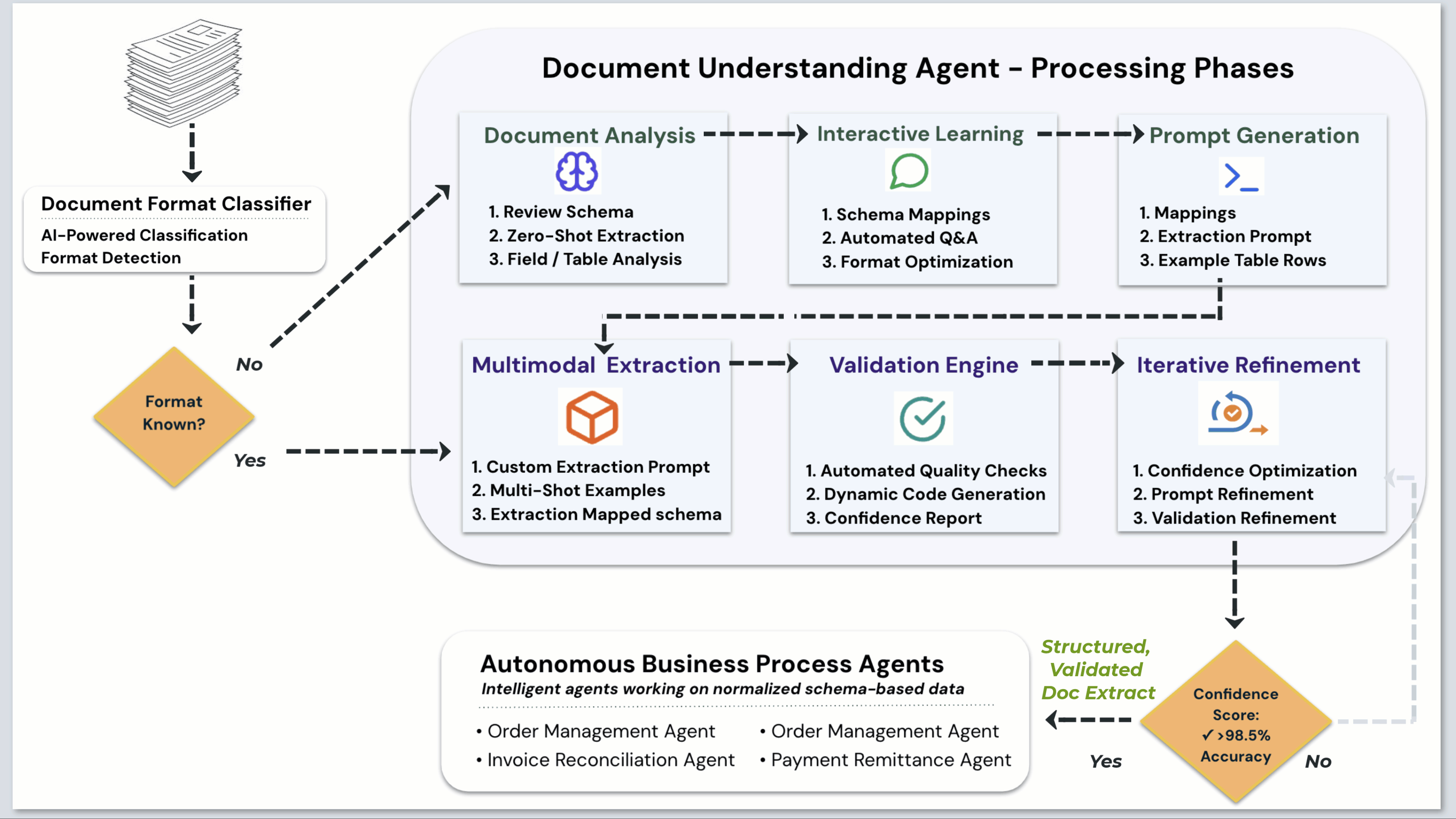
The Document Understanding Agent’s five-phase workflow transforms complex documents into structured data for autonomous business processing.
At its core, the DUA orchestrates a seamless flow from initial document analysis through final validation, guided by business expertise at every step. Through five integrated phases — Document Analysis, Interactive Learning, Prompt Generation, Multimodal Extraction, and Validation — the DUA turns what was traditionally a technical challenge requiring months of development into a business-led collaboration that delivers results in minutes.
This systematic approach transforms document processing through a clearly defined workflow:

The Document Understanding Agent’s five-phase workflow transforms complex documents into structured data for autonomous business processing, combining intelligent analysis with precision validation.
The document-centric process challenge
Enterprises today face a critical challenge in automating complex document-centric business processes. Consider order management as an example. When a customer sends a purchase order, it triggers two distinct but interconnected phases:
1. Execute the business process using the extracted data
2. Extract and validate purchase order documents into standardized formats
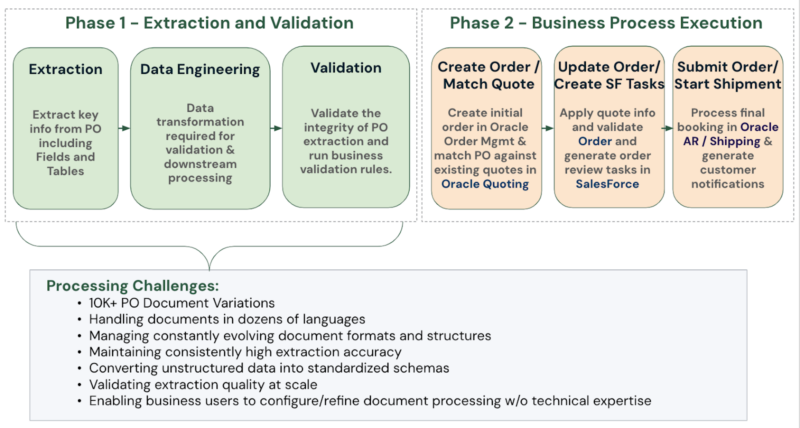
The two-phase challenge of document automation: transforming unstructured documents into actionable business data while managing complex processing requirements.
Recent advances in AI agents have transformed how organizations can automate complex business processes. Our Purchase Order Management Agent demonstrates how AI can now intelligently execute sophisticated workflows that have traditionally been difficult to automate — from creating initial orders and matching quotes to updating pricing details, submitting bookings, and capturing analytics for optimization.
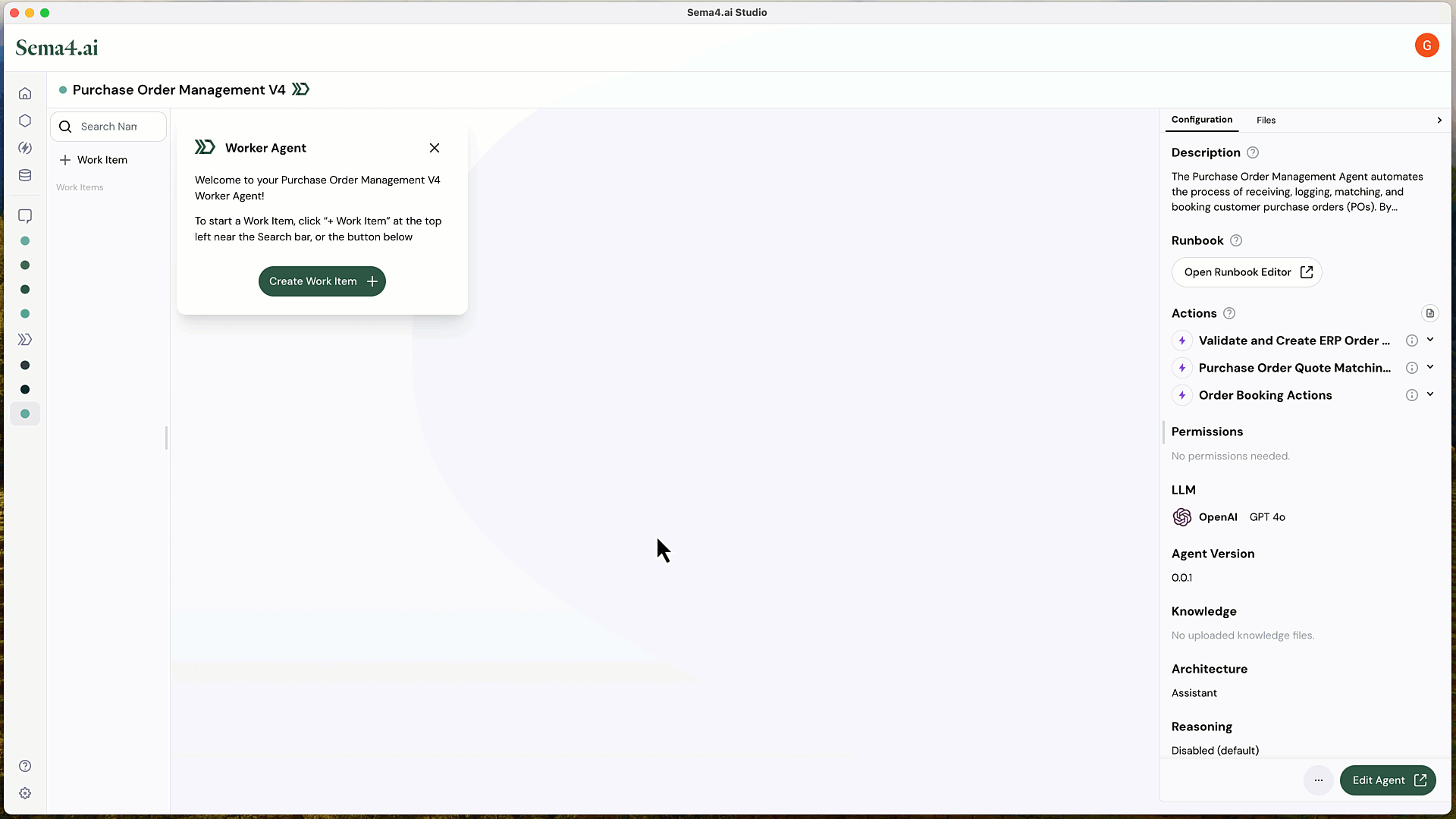
Purchase Order Management Agent automating the complete business process for an Italian PO — from creating initial orders and matching quotes to validating details, updating order information, creating Salesforce tasks, and finalizing order submission and shipping.
However, a more fundamental challenge has prevented many organizations from achieving true end-to-end automation — Phase 1: the document understanding and data extraction challenge. For large enterprises, this means processing tens of thousands of document variations across multiple business processes, handling documents in dozens of languages, and maintaining consistently high extraction accuracy — all while enabling business users to configure and refine document processing without technical expertise.
The schema challenge: bridging unstructured documents to structured business processing
The complexity of this challenge becomes clear when we examine what Phase 2 requires: a precise, standardized schema that defines exactly how document data must be structured for downstream processing. A typical purchase order schema specifies transaction details, hierarchical structures for shipping and billing information, line item tables with relationships between quantities and prices, and validation rules ensuring mathematical consistency. This standardized schema is essential for reliable business processing but creates an enormous technical challenge in Phase 1.
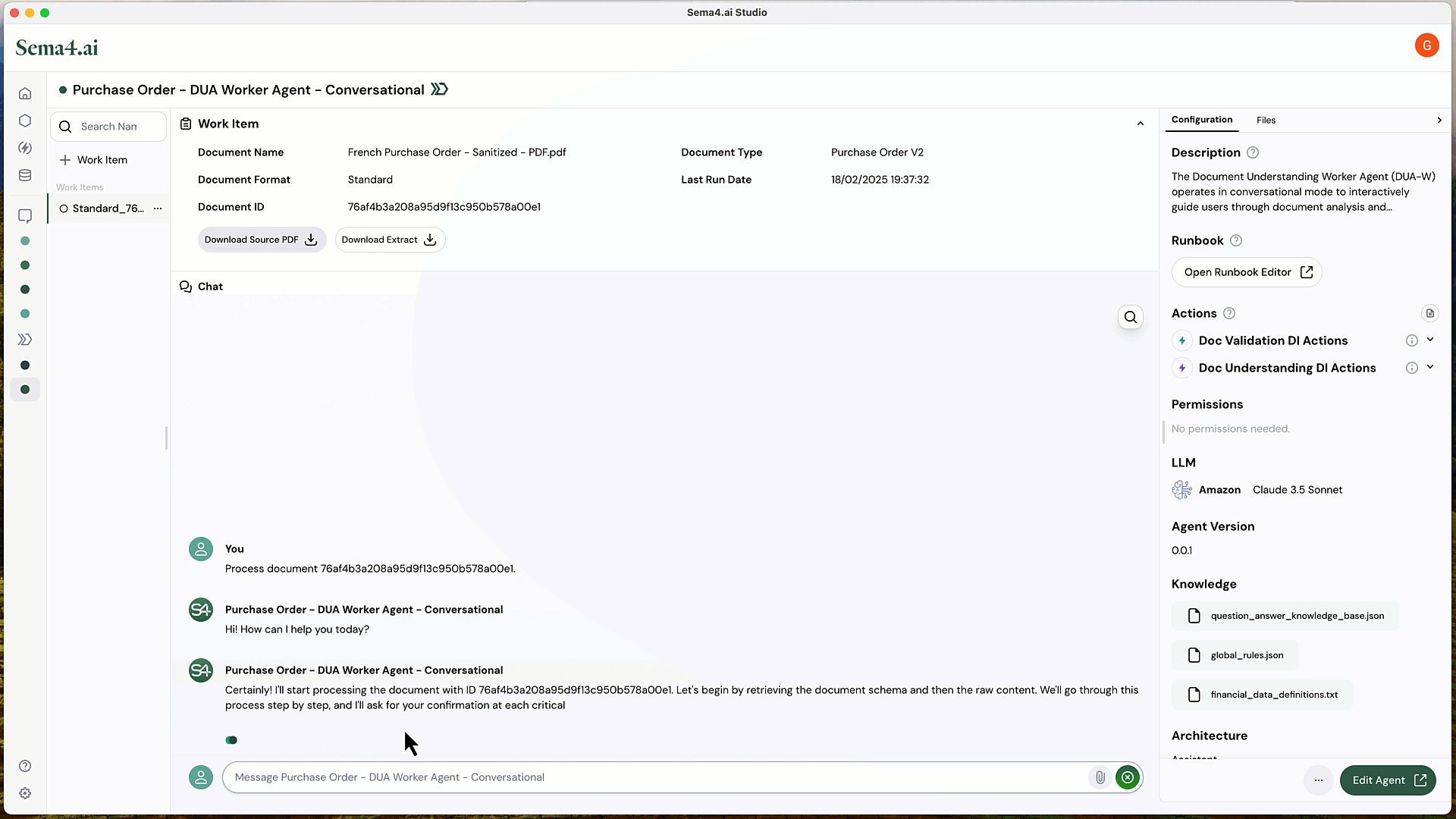
Document Understanding Agent displaying a standardized purchase order schema with required fields and table structures needed for downstream processing.
This standardized schema is essential for reliable business processing, but it creates an enormous technical challenge in Phase 1.
How do you automatically extract and transform unstructured documents of wildly varying formats into this rigid structure while maintaining consistently high accuracy?
One of our customers, a Fortune 100 multinational manufacturing company, illustrates this challenge perfectly. They receive purchase orders from suppliers and partners across 30 countries, each document arriving in its local language and following regional business conventions. Regardless of origin, every document must be transformed into a standardized schema for their global procurement system. This transformation represents the critical gap that has prevented true end-to-end automation — until now.
Enter the Document Understanding Agent
This is where our Document Understanding Agent (DUA) represents a fundamental breakthrough in enterprise document automation. Rather than requiring rigid templates, complex code, or manual configuration, the DUA works as an intelligent partner that guides business users through document understanding using natural conversation while autonomously handling the most complex processing tasks behind the scenes.
To demonstrate this capability, let’s examine three representative purchase orders that showcase the complexity faced by global enterprises processing documents across different regions, languages, and formats:
- A US-based purchase order following SAP Business Network standards
- A French purchase order with complex nested department structures
- An Italian purchase order requiring sophisticated data derivation
Each document contains the same fundamental information required by our schema but presents it in radically different ways — varying not just in language and terminology but in fundamental document structure, field relationships, and calculation methods. Traditional approaches to this problem, whether template-based extraction or simple OCR, have failed to achieve the accuracy and scalability enterprises require.
This challenge — taking unstructured documents of such diversity and automating their transformation into a complex schema with high accuracy — makes Phase 1 particularly difficult. It requires a sophisticated understanding of both document structure and business context that, until now, only human experts could provide.
Let’s examine how the Document Understanding Agent transforms this challenge through its systematic five-phase approach, beginning with Document Analysis.
Phase 1: intelligent document analysis — the foundation of understanding
Consider the Italian purchase order. At first glance, this appears to be a standard Purchase Order document. However, a closer look reveals that neither an explicit Total Amount field nor a Line Total column exists in the line items table.

This Italian purchase order lacks an explicit Total Amount field and Line Item Total column, creating challenges for automated processing.
Traditional document processing systems would either fail to extract these missing fields or require extensive custom development, significantly slowing down automation efforts.
This is where the Document Understanding Agent (DUA) demonstrates its differentiating capabilities. DUA doesn’t just analyze — it actively solves the problem by deriving missing fields, applying inference rules, and ensuring regional formatting consistency. Rather than flagging missing fields as errors, the DUA creates solutions. It derives the Total Amount as the sum of line totals, formats it correctly, and assigns a confidence score — automating what once took weeks of coding.

Watch the Document Understanding Agent (DUA) intelligently analyze non-table and table elements from the Italian PO, deriving missing values and ensuring structured data integrity.
Even more impressive is how the DUA handles the line items table. Instead of treating missing values as obstacles, it intelligently bridges the gap between document content and business rules. It automatically derives Line Total calculations, ensuring consistency across the document. Currency formatting remains precise, and validation rules guarantee mathematical integrity. The agent also preserves critical relationships between quantities, unit prices, and totals — maintaining data accuracy without manual intervention.
What once took weeks of custom development is now automated in minutes. But this isn’t just about faster processing — it’s about true document understanding. The DUA doesn’t just extract data; it interprets structure and meaning, mirroring human expertise with AI precision.
This intelligence sets the stage for the next processing phases. More importantly, it makes complex analysis accessible in business-friendly terms. Instead of sifting through raw data, users can engage with the agent naturally — validating, refining, and improving extraction through a seamless, conversational interface.
Phase 2: interactive learning — transforming data engineering into business dialogue
Traditional systems rely on engineers to manually write complex data transformation rules, slowing automation and increasing errors. Consider this French purchase order, which presents a classic data engineering challenge:
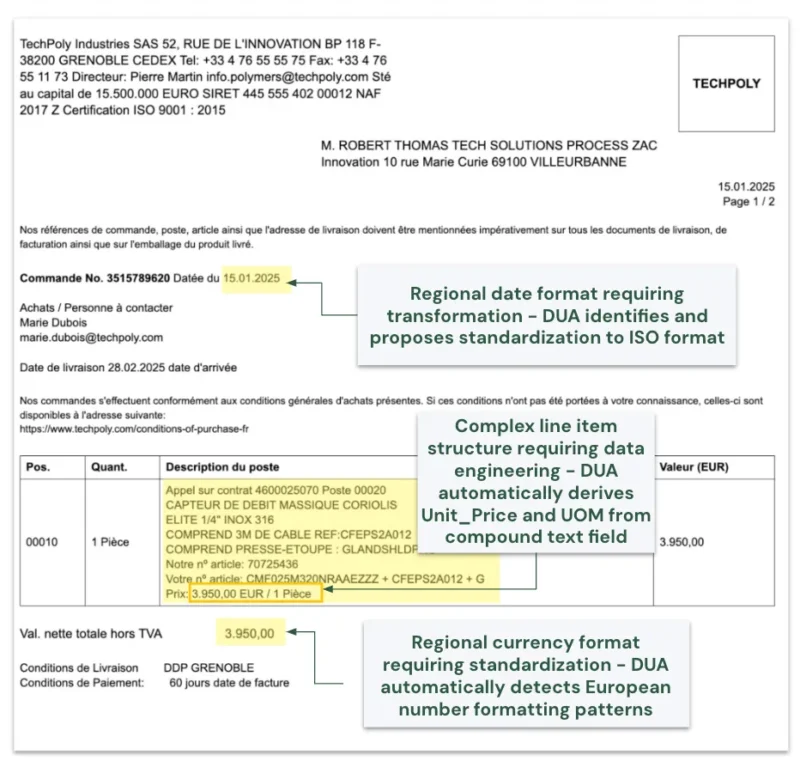
This French purchase order presents complex data engineering challenges — requiring currency, date format, and unit price standardization for structured processing.
Manually transforming this document could take weeks — engineers writing ETL scripts, SQL transformations, and handling region-specific formats.
The DUA eliminates complexity, turning tedious data engineering into a simple business conversation.
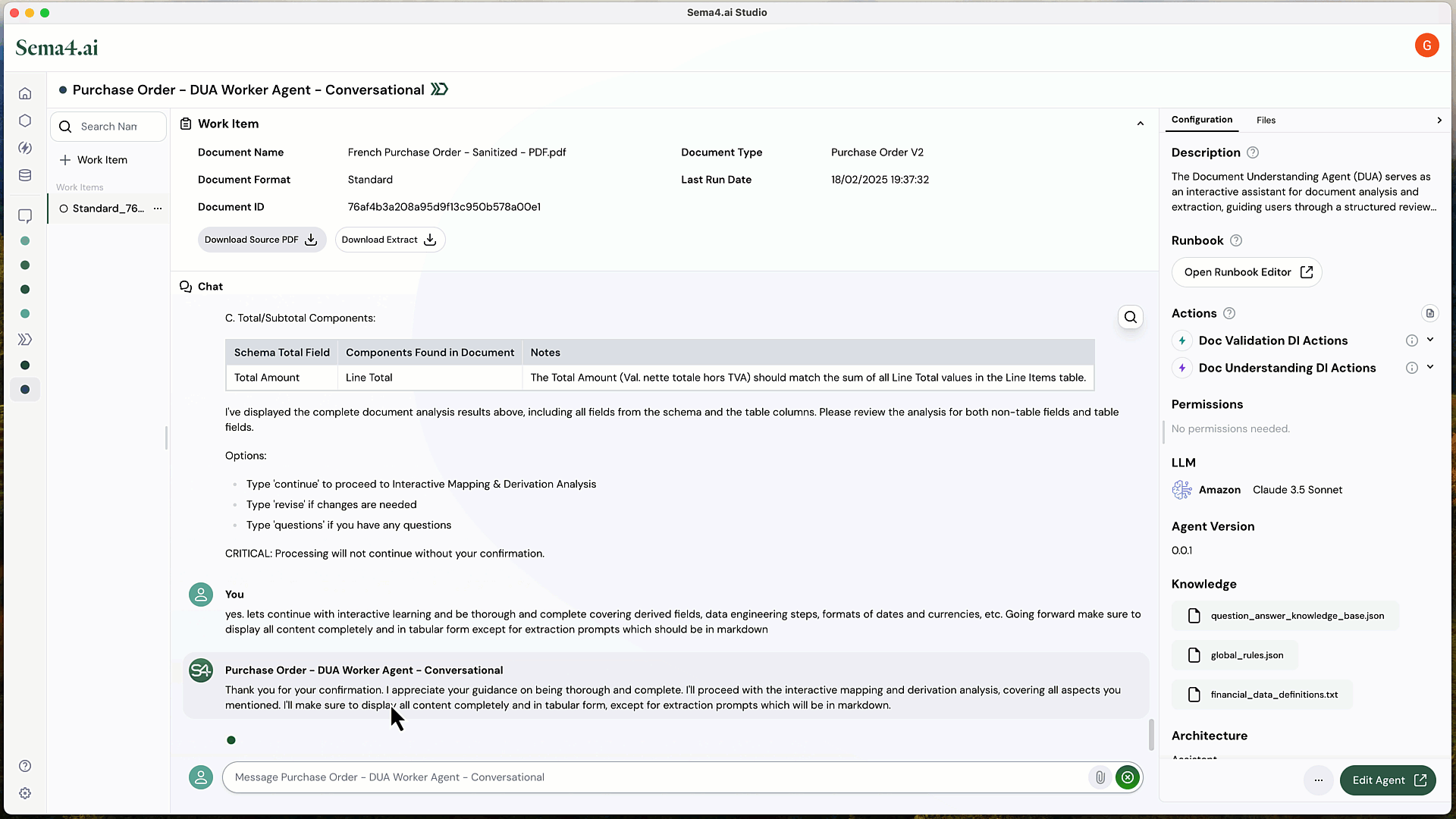
Watch how the DUA learns in real-time — engaging in dialogue with users to refine extraction logic, resolve ambiguities, and automate data transformation decisions for the French PO.
The DUA converts user choices into precise rules, handling currency formats, unit price calculations, and date standardization — all in real-time.
This transformation from technical complexity to business dialogue enables analysts to configure sophisticated document processing in minutes rather than weeks while maintaining precise control over how their documents are processed.
Phase 3 & 4: extraction prompt generation & multimodal execution — where business understanding becomes technical reality
The DUA bridges business understanding and technical execution — automating extraction with precision and intent. Let’s examine this through two examples showcasing different aspects of the DUA’s capabilities.
The DUA adapts to European formats for the French PO — standardizing currency, dates, and structure with precise extraction prompts.

DUA automatically generates precise extraction prompts when processing the French PO, adapting to European formats for currency, dates, and structured line items.
Below, the Italian PO highlights the DUA’s intelligent restraint — knowing when to extract and when to defer calculations for accuracy.
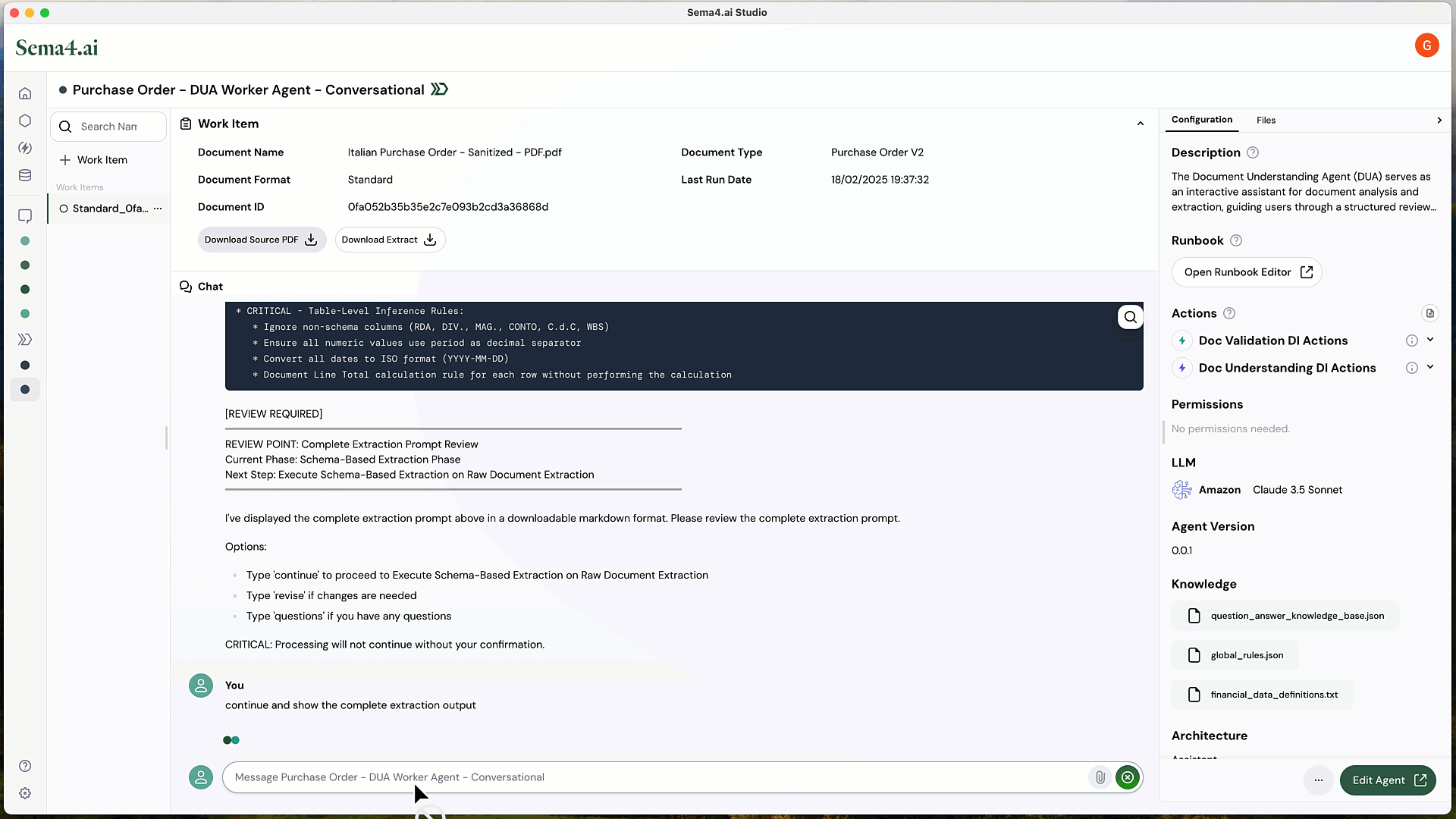
Watch the DUA intelligently extract structured data from the Italian PO while preserving original values — deferring calculations to ensure computational precision.
The DUA intelligently defers calculations to the transformation phase, ensuring accuracy and auditability. Instead of prematurely computing totals, it extracts and preserves data in its original form, marking Total_Amount as “Derived from Line Items” and maintaining the table structure without modifying values. This deliberate design choice ensures:
- Data integrity — original values remain unchanged.
- Computational precision — calculations execute in a dedicated transformation phase.
- Full auditability — traceable from source data to final results.
- Validation accuracy — derivation rules enforce mathematical consistency.
- Deterministic execution — validations run in a controlled action framework, not via LLM inference, ensuring predictable and repeatable results.
Phase 5: transformation & validation — where AI intelligence meets computational precision
The DUA revolutionizes document automation by combining AI-driven intelligence with precise, controlled validation. Its architecture uniquely combines three powerful capabilities:
- Intelligent code generation: The DUA leverages advanced language models to generate precise transformation and validation code, incorporating business requirements captured during document analysis and interactive learning.
- Deterministic execution: Rather than relying on AI for calculations, the generated code executes in a controlled action framework, ensuring mathematical precision and reproducible results.
- Confidence-driven workflow: Validation results generate a confidence score that automatically determines next steps — either proceeding to business processing or engaging human expertise for refinement.
Let’s see how these capabilities come together through two compelling examples that showcase the DUA’s unique ability to combine AI flexibility with computational precision.
From intelligent analysis to precise execution: the transformation pipeline
Remember the Italian purchase order we examined earlier? The DUA intelligently identifies and derives missing fields like Total Amount and Line Total but defers calculations to maintain mathematical precision.
This is where the transformation phase ensures accuracy. Instead of estimating totals during analysis, the DUA generates structured transformation code, enforcing strict decimal arithmetic, dependency chains, and consistent numeric formatting.
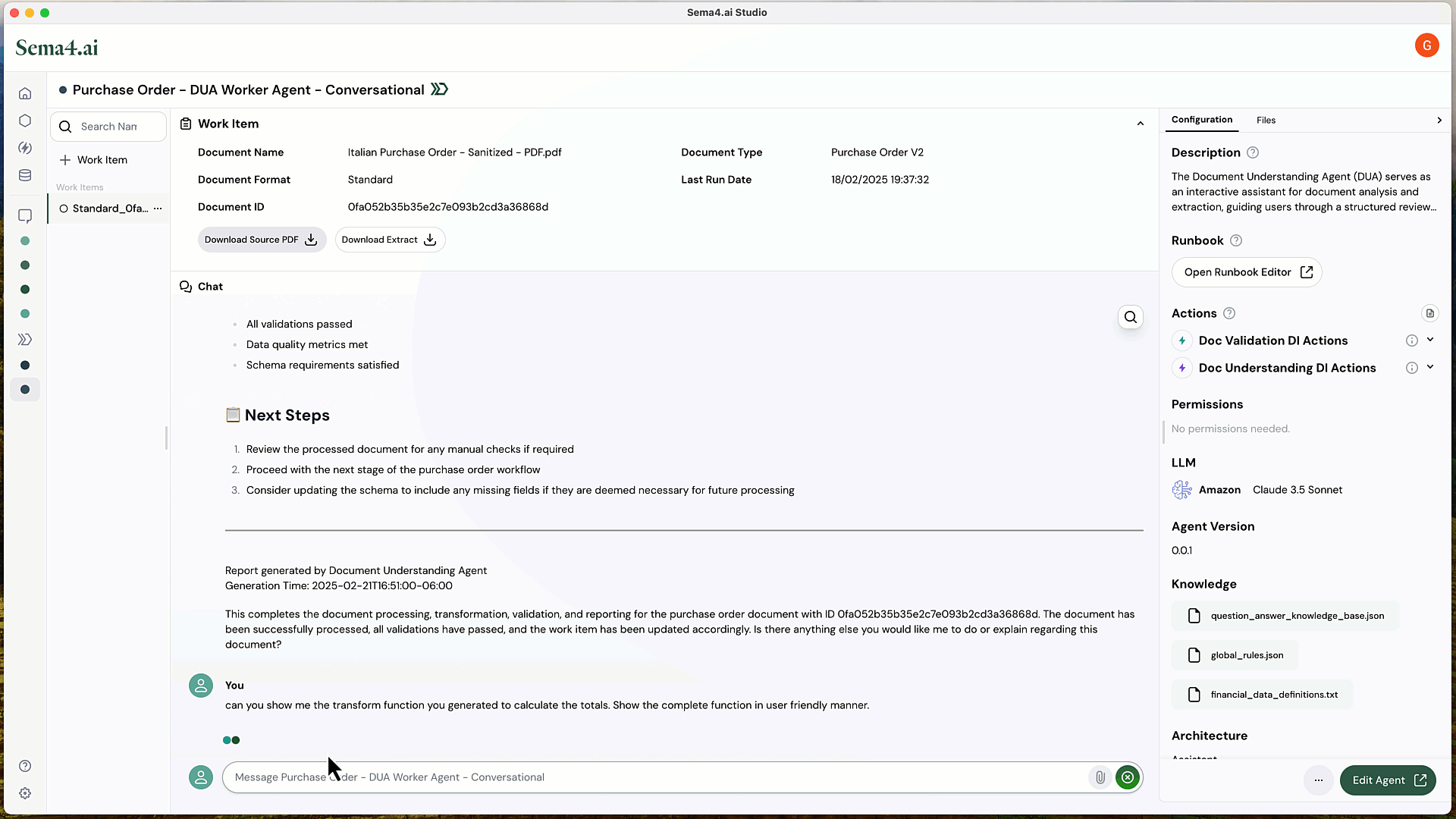
DUA autonomously generates transformation code to derive Line Item Total and Total Amount for the Italian PO, ensuring structured and accurate financial calculations.
DUA executes this logic deterministically within a controlled action framework. In the Italian PO example, it first computes Line Total per row, then derives the Total Amount through validated aggregation, and standardizes currency formatting — eliminating rounding errors and ensuring financial precision.
This architectural approach bridges AI adaptability with computational accuracy, leveraging language models for intelligent extraction while enforcing strict validation in a structured execution environment.
Beyond extraction: intelligent validation that ensures business accuracy
Validation turns document analysis into actionable business insights. Consider this US purchase order, where a discrepancy emerges: line items total $3,550.00, but the document states $2,750.25 — a $799.75 difference.
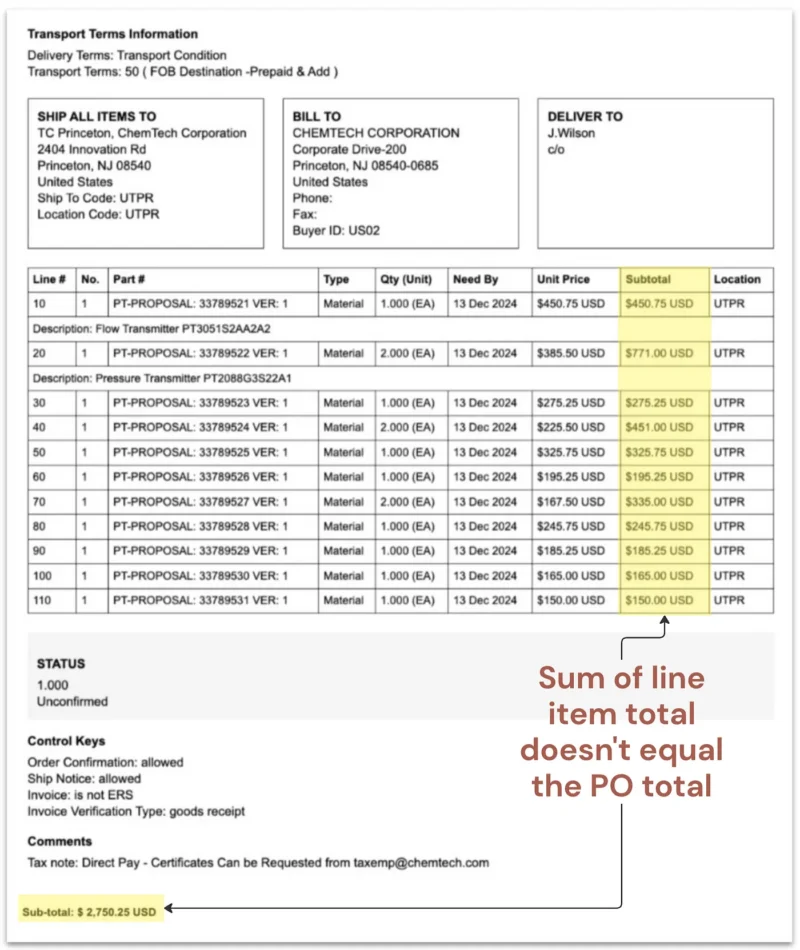
Discrepancy detected in the US PO: The sum of line item totals ($3,550.00) does not match the stated PO total ($2,750.25), highlighting a critical validation failure.
Traditionally, such mismatches required manual review or custom scripts. DUA eliminates this complexity by automating validation through a structured, three-step process:
- Intelligent rule generation: Analysts define validation rules in plain language — DUA translates them into precise, executable logic.
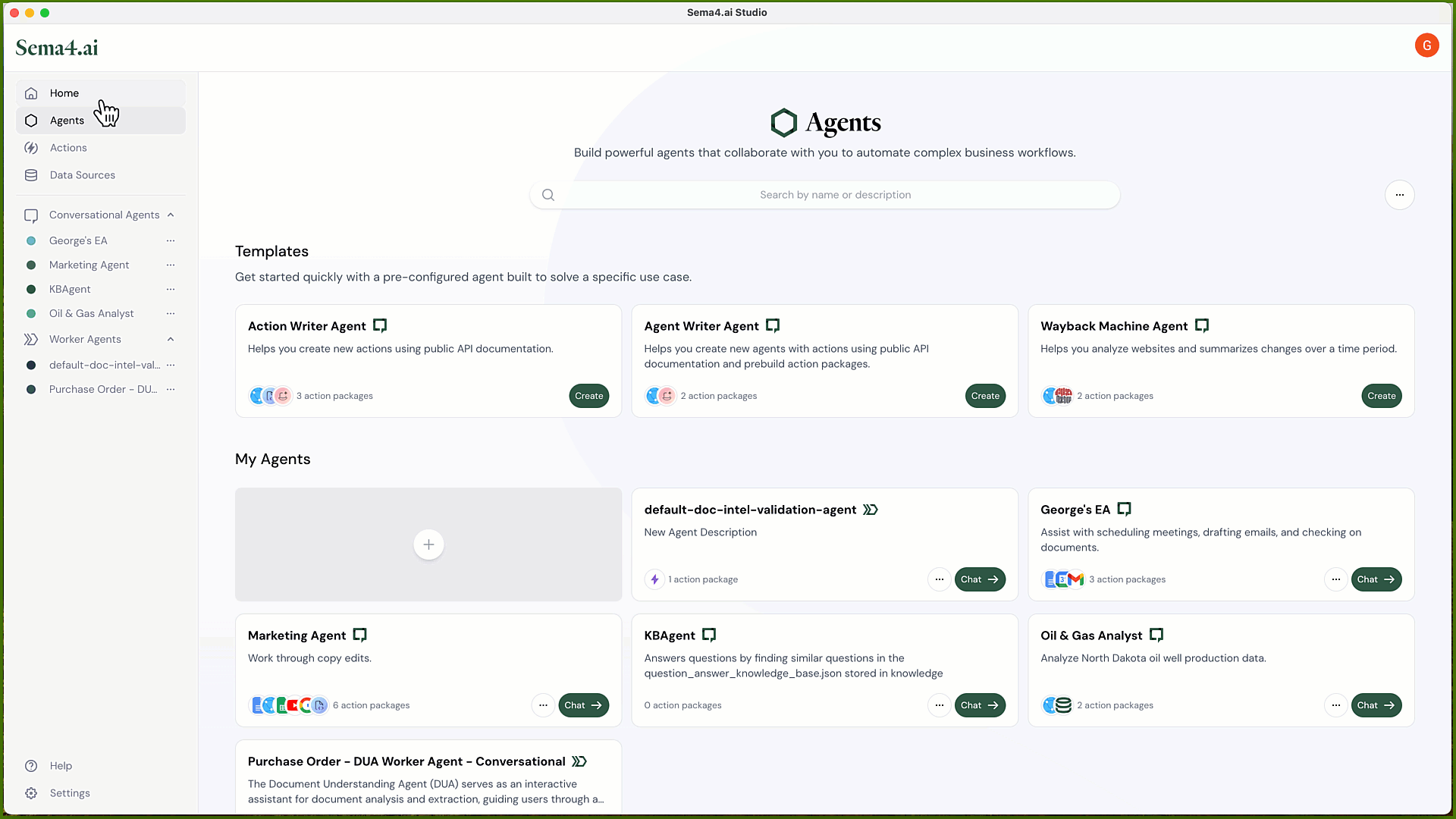
Business analysts define validation rules in plain language — DUA translates them into precise, executable validation logic.
- Precision-first execution: DUA generates Python validation functions that run in a controlled action framework, ensuring strict decimal handling and computational accuracy.
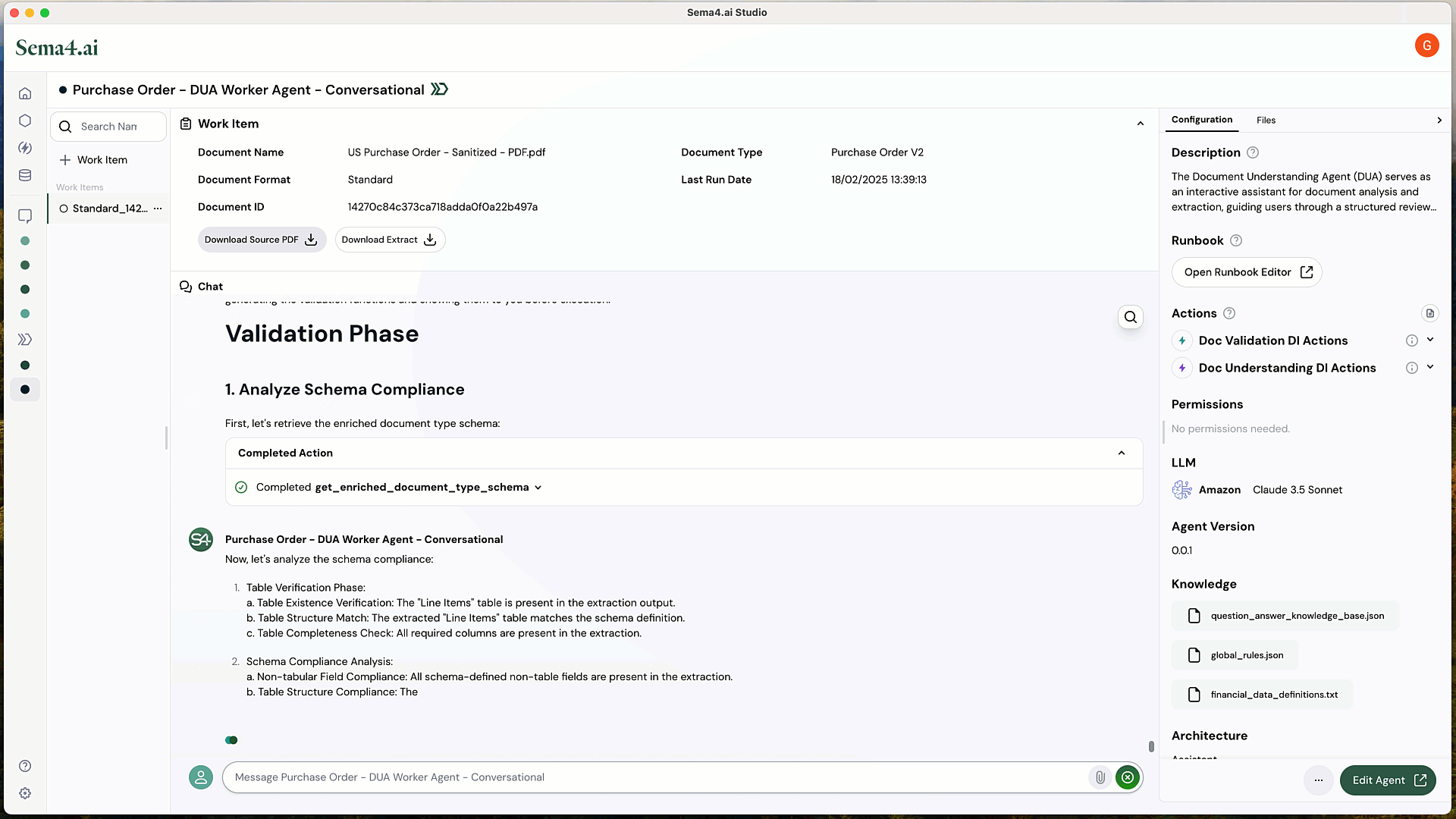
DUA automatically generates Python validation code to enforce business rules, ensuring transactional accuracy in purchase orders.
- Actionable reporting: Instead of just flagging errors, DUA produces a structured validation report, allowing users to verify discrepancies and download supporting evidence.
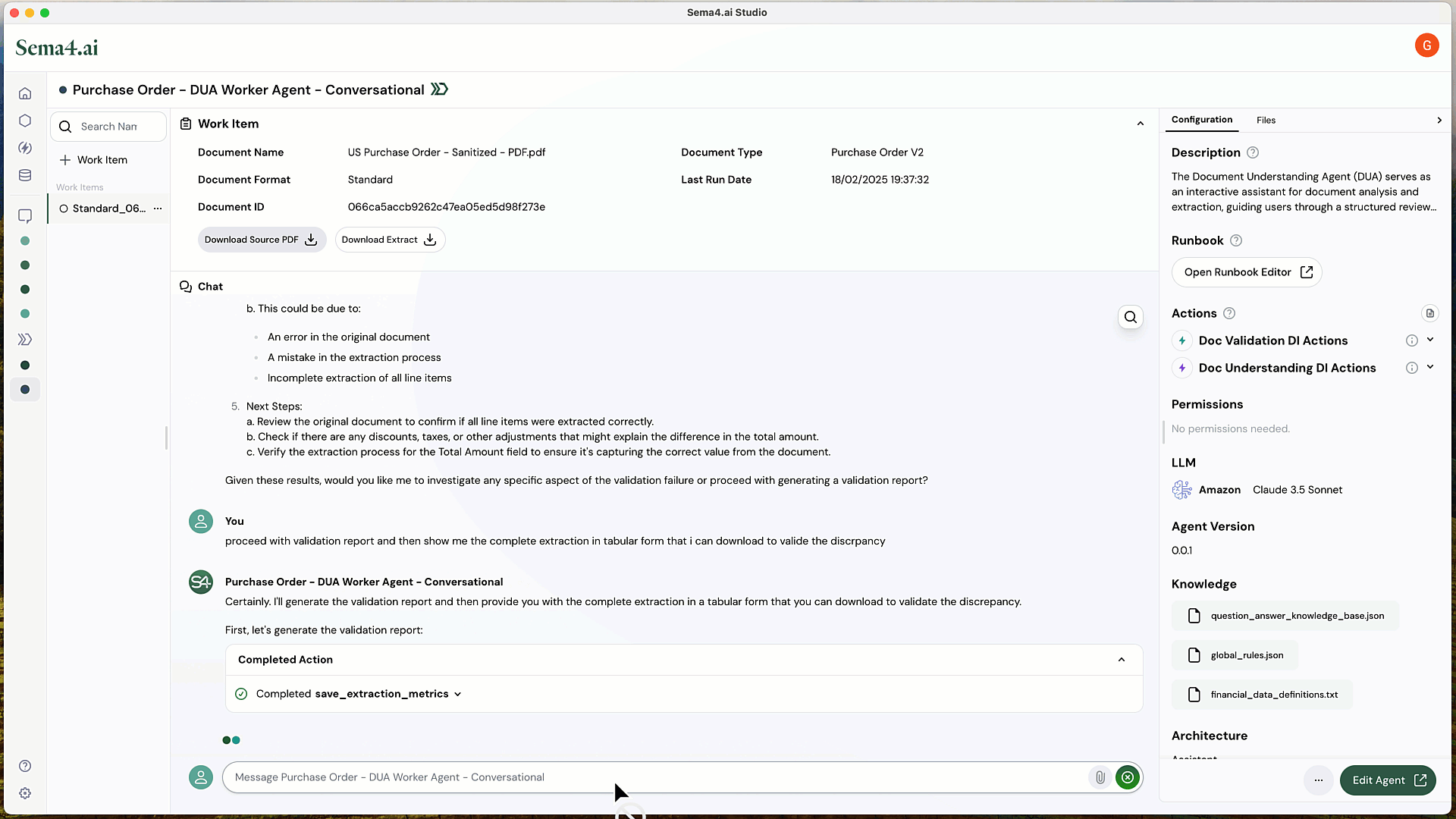
DUA produces a structured validation report with actionable insights — allowing users to review discrepancies and verify extracted data with downloadable evidence.
This validation framework transforms a historically complex process into a business enabler, ensuring:
- Automated, no-code rule definition for business analysts.
- Guaranteed mathematical precision through deterministic execution.
- Rich audit trails to track and resolve discrepancies.
- Context-driven issue resolution, providing actionable insights to efficiently address discrepancies.
The new era of document processing: business-led, AI-powered
Our journey through the French, Italian, and US purchase orders illustrates a fundamental shift in document automation — where AI no longer just extracts data but understands, validates, and collaborates in a business-led process.
- The French purchase order showed how DUA eliminates manual data engineering. Instead of writing transformation scripts, business users define rules in natural language, and DUA automates format standardization — bridging raw documents with structured business needs.
- The Italian purchase order demonstrated how AI can infer missing financial data while preserving accuracy. DUA identifies necessary calculations but defers execution to ensure strict decimal precision and auditability — what once required custom ETL pipelines is now fully automated.
- The US purchase order highlighted validation as a business-driven process. Instead of manual reviews, DUA detects discrepancies, enforces rules, and generates reports, providing not just error detection but rich contextual insights for resolution.
For enterprises, the impact is clear — what once took months now takes minutes, and what required constant oversight is now automated end-to-end. This is the future of document intelligence: AI as a partner that merges business expertise with computational precision for true enterprise-grade automation.


